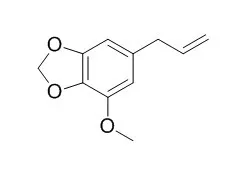| Description: |
Myristicin has anti-cholinergic, antibacterial, and hepatoprotective effects, it also has anti-inflammatory properties related with its inhibition of NO, cytokines,chemokines, and growth factors in dsRNA-stimulated macrophages via the calcium pathway. Myristicin may antagonize the anxiolytic effects of midazolam, increase anxiety, and affect motor movements. Myristicin can induce apoptosis as characterised by alterations in the mitochondrial membrane potential, cytochrome c release, caspase-3 activation, PARP-cleavage and DNA fragmentation. |
| Targets: |
P450 (e.g. CYP17) | Bcl-2/Bax | Caspase | PARP | NO | IL Receptor | GABA Receptor | Antifection |
| In vitro: |
| Molecules. 2011;16(8):7132-42. | | Anti-inflammatory effect of myristicin on RAW 264.7 macrophages stimulated with polyinosinic-polycytidylic acid.[Pubmed: 21991618] | Myristicin (1-allyl-5-methoxy-3,4-methylenedioxybenzene) is an active aromatic compound found in nutmeg (the seed of Myristica fragrans), carrot, basil,cinnamon, and parsley. Myristicin has been known to have anti-cholinergic, antibacterial,and hepatoprotective effects, however, the effects of Myristicin on virus-stimulated macrophages are not fully reported.
METHODS AND RESULTS:
In this study, the anti-inflammatory effect of Myristicin on double-stranded RNA (dsRNA)-stimulated macrophages was examined. Myristicin did not reduce the cell viability of RAW 264.7 mouse macrophages at concentrations of up to 50 μM. Myristicin significantly inhibited the production of calcium, nitric oxide (NO),interleukin (IL)-6, IL-10, interferon inducible protein-10, monocyte chemotactic protein(MCP)-1, MCP-3, granulocyte-macrophage colony-stimulating factor, macrophage inflammatory protein (MIP)-1α, MIP-1β, and leukemia inhibitory factor in dsRNA[polyinosinic-polycytidylic acid]-induced RAW 264.7 cells (P < 0.05).
CONCLUSIONS:
In conclusion,Myristicin has anti-inflammatory properties related with its inhibition of NO, cytokines,chemokines, and growth factors in dsRNA-stimulated macrophages via the calcium pathway. |
|
| In vivo: |
| AANA J. 2011 Apr;79(2):109-14. | | Evaluation of the anxiolytic properties of myristicin, a component of nutmeg, in the male Sprague-Dawley rat.[Pubmed: 21560973] | The purpose of this study was to investigate the anxiolytic effects of Myristicin, a major compound found in nutmeg, and its potential interaction with the gamma-aminobutyric acid (GABA(A)) receptor in male Sprague-Dawley rats.
METHODS AND RESULTS:
Nutmeg has traditionally been used as a spice in food preparation and as an herbal remedy in the treatment of many medical conditions, including anxiety. Fifty-five rats were divided equally into 5 groups: control (vehicle); Myristicin; midazolam (positive control); flumazenil and Myristicin; and midazolam and Myristicin. The behavioral component of anxiety was examined by using the elevated plus-maze (open-arm and closed-arm times) along with analysis of gross and fine motor movements. Data analysis was performed using a 2-tailed multivariate analysis of variance (MANOVA) and least significant difference post-hoc test.
CONCLUSIONS:
Our data suggest that Myristicin does not decrease anxiety by modulation of the GABA(A) receptor but may promote anxiogenesis. When Myristicin was combined with midazolam, an antagonist-like effect similar to the flumazenil and Myristicin combination was exhibited by a decrease in anxiolysis compared with the midazolam-only group. Myristicin may antagonize the anxiolytic effects of midazolam, increase anxiety, and affect motor movements. |
|






 Cell. 2018 Jan 11;172(1-2):249-261.e12. doi: 10.1016/j.cell.2017.12.019.IF=36.216(2019)
Cell. 2018 Jan 11;172(1-2):249-261.e12. doi: 10.1016/j.cell.2017.12.019.IF=36.216(2019) Cell Metab. 2020 Mar 3;31(3):534-548.e5. doi: 10.1016/j.cmet.2020.01.002.IF=22.415(2019)
Cell Metab. 2020 Mar 3;31(3):534-548.e5. doi: 10.1016/j.cmet.2020.01.002.IF=22.415(2019) Mol Cell. 2017 Nov 16;68(4):673-685.e6. doi: 10.1016/j.molcel.2017.10.022.IF=14.548(2019)
Mol Cell. 2017 Nov 16;68(4):673-685.e6. doi: 10.1016/j.molcel.2017.10.022.IF=14.548(2019)